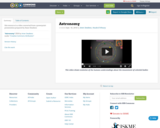
this resource is a video converted from a powerpoint presentation prepared by Amer Deaibess
- Subject:
- Astronomy
- Physical Science
- Material Type:
- Activity/Lab
- Date Added:
- 09/17/2018

this resource is a video converted from a powerpoint presentation prepared by Amer Deaibess
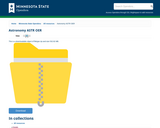
Full course with supplemental materials based upon the OpenStax Astronomy textbook.
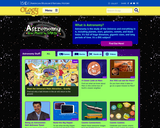
This website has five great astronomy activities! By engaging in these activities, you can learn about the Milky Way Galaxy, the Sun, the Big Dipper, and stars!

This file contains two activities created by Robert Wagner of Harrisburg Area Community College. The Scientific Article Assignment provides a framework for students to analyze and interpret a level-appropriate scientific article. The Solar Observation project guides students through a more extensive observation activity, and includes a setup for data recording and reporting.
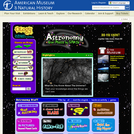
This reference list has 11 kid-friendly books on a wide range of astronomy topics. For each title, the publisher and publication date are included along with author name.
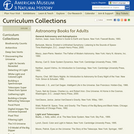
This reference list has more than 20 recommended astronomy books for older students and adults. For each title, the publisher and publication date is included, along with author name. The list is divided into three subcategories: General Astronomy and Astrophysics, Light and Telescopes, and Digital Imaging and the 3-D Universe.
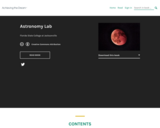
Word Count: 23429
(Note: This resource's metadata has been created automatically by reformatting and/or combining the information that the author initially provided as part of a bulk import process.)

Word Count: 20458
(Note: This resource's metadata has been created automatically by reformatting and/or combining the information that the author initially provided as part of a bulk import process.)
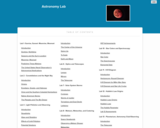
13 Labs with unique subjects. Does not include quizzes. Also available in Pressbooks (https://fscj.pressbooks.pub/astronomy/).

บทนำ ระบบสุริยะ เป็นระบบที่มีดวงอาทิตย์เป็นศูนย์กลาง และมีดาวบริวารเคลื่อนวนอยู่โดยรอบมีอายุประมาณ 5,000 ล้านปี โดยเป็นผลมาจากการระเบิดของเนบิวลาหรือดาวขนาดใหญ่ เรียกว่า มหานวดารา (Supernova) โดยเนบิวลาจะเกิดการยุบตัวด้วยแรงโน้มถ่วง จนในที่สุดเกิดสภาวะสมดุลระหว่างแรงโน้มถ่วงกับแรงดันของแก๊สทำให้สามารถเปล่งแสงออกมาได้ เรียกว่า ดาวฤกษ์ โดยระบบสุริยะมีดวงอาทิตย์เป็นดาวฤกษ์ ส่วนเศษฝุ่นแก๊สที่เหลือเมื่อเย็นตัวลง จะกลายเป็นดาวเคราะห์หมุนรอบดวงอาทิตย์จุดประสงค์ความรู้ (Knowledge) 1.อธิบายการเกิดของระบบสุริยะ และดาวเคราะห์ต่างๆ ได้ 2.อธิบายองค์ประกอบของระบบสุริยะได้ทักษะ/กระบวนการ (Process Skill) 1. เปรียบเทียบความต่างของดาวฤกษ์กับดาวเคราะห์ได้ 2. มีทักษะการคิดวิเคราะห์ จัดเรียงข้อมูล และสรุปผลก่อนนำเสนอได้ 3. สืบค้นความรู้จากแหล่งเรียนรู้ต่างๆ โดยใช้เทคโนโลยีได้ด้านคุณลักษณะอันพึงประสงค์ 1. มีความซื่อสัตย์สุจริต 2. มีวินัย 3. ใฝ่เรียนรู้ 4. มุ่งมั่นในการทำงาน 5. มีจิตสาธารณะ 6. มีจิตวิทยาศาสตร์-มาตรฐาน/ ตัวชี้วัดมาตรฐานการเรียนรู้/ตัวชี้วัด มาตรฐาน ว 7.1: เข้าใจวิวัฒนาการของระบบสุริยะ กาแล็กซี และเอกภพ การปฏิสัพันธ์ภายในระบบสุริยะและผลต่อสิ่งมีชีวิต มีกระบวนการสืบเสาะหาความรู้และจิตวิทยาศาสตร์ สื่อสารสื่งที่เรียนรู้และนำความรู้ไปใช้ประโยชน์ ตัวชี้วัด: ว 7.1 ม 4-6/2 สืบค้นและอธิบายธรรมชาติและวิวัฒนาการของดาวฤกษ์

บทนำ โลกเป็นดาวเคราะห์หินดวงหนึ่งในระบบสุริยะ ภายในโลกยังคงมีอุณหภูมิสูงแลมีการเปลี่ยนแปลงตลอดเวลา การแบ่งโครงสร้างโลกโดยใช้ข้อมูลและหลักฐานต่างๆทางธรณีวิทยา และทางฟิสิกส์ การเปลี่ยนแปลงของโลกสามารถอธิบายได้ด้วยทฤษฎีการแปรสัณฐานแผ่นธรณีภาค ส่วนใหญ่จะเกิดในชั้นธรณีภาคและชั้นฐานธรณีภาค แผ่นดินไหวและภูเขาไฟส่วนใหญ่จะเกิดอยู่ตามแนวรอยตะเข็บของขอบแผ่นธรณีภาคที่เรียกว่า วงแหวนแห่งไฟ กระบวนการเกิดรอยเลื่อน รอยคดโค้ง การแปรสัณฐานแผ่นธรณีภาคเป็นส่วนหนึ่งของการเกิดเทือกเขาบนโลกมาตรฐานการเรียนรู้/ตัวชี้วัด สาระที่ 6 กระบวนการเปลี่ยนแปลงของโลก มาตรฐาน ว 6.1 เข้าใจกระบวนการต่างๆ ที่เกิดขึ้นบนผิวโลกและภายในโลก ความสัมพันธ์ของกระบวนการต่างๆ ที่มีผลต่อการเปลี่ยนแปลงภูมิอากาศ ภูมิประเทศ และสัณฐานของโลก มีกระบวนการสืบเสาะหาความรู้และจิตวิทยาศาสตร์สื่อสารสิ่งที่เรียนรู้และนำความรู้ไปใช้ประโยชน์ ตัวชี้วัด 1. สืบค้นและอธิบายหลักการในการแบ่งโครงสร้างโลก 2. ทดลองเลียนแบบและอธิบายกระบวนการเปลี่ยนแปลงทางธรณีภาคของโลก 3. ทดลองเลียนแบบและอธิบายกระบวนการเกิดภูเขา รอยเลื่อน รอยคดโค้ง แผ่นดินไหว ภูเขาไฟระเบิด สาระที่ 8 ธรรมชาติของวิทยาศาสตร์และเทคโนโลยี มาตรฐาน ว 8.1 ใช้กระบวนการทางวิทยาศาสตร์และจิตวิทยาศาสตร์ในการสืบเสาะหาความรู้ การแก้ปัญหารู้ว่า ปรากฏการณ์ทางธรรมชาติที่เกิดขึ้นส่วนใหญ่มีรูปแบบที่แน่นอน สามารถอธิบายและตรวจสอบได้ ภายใต้ข้อมูลและเครื่องมือที่มีอยู่ในช่วงเวลานั้น เข้าใจว่าวิทยาศาสตร์ เทคโนโลยี สังคม และสิ่งแวดล้อมมีความเกี่ยวข้องสัมพันธ์กัน
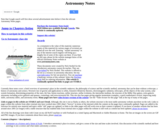
Astronomy Notes is a website with a brief overview of astronomy's place in the scientific endeavor, the philosophy of science and the scientific method, astronomy that can be done without a telescope, a history of astronomy and science, Newton's law of gravity and applications to orbits, Einstein's Relativity theories, electromagnetic radiation, telescopes, all the objects of the solar system, solar system formation, determining properties of the stars, the Sun, fusion reactions, stellar structure, stellar evolution, the interstellar medium, the structure of the Milky Way galaxy, extra-galactic astronomy including active galaxies and quasars, cosmology, and extra-terrestrial life. This site also has pages giving angular momentum examples, a quick mathematics review, improving study skills, astronomy tables, and astronomy terms
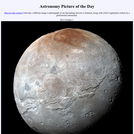
This site shows daily (back to June 16, 1995) a different image or photograph of the universe along with a brief explanation written by a professional astronomer.
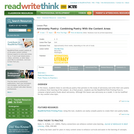
Students' responses to this lesson will be out of this world after they've researched astronomy to write poetry and compile a poetry book.
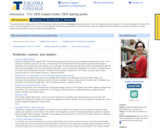
This guide compiles starting points for OER and freely available resources for Astronomy courses and topics. This OER subject guide was created for TCC faculty and staff and reflects TCC credit, continuing education, and corrections course offerings. The purpose of this guide is to help faculty and staff more easily find and review OER in their areas so that they can make decisions about quality, accuracy, relevancy, and potential use.
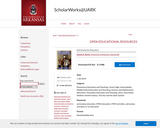
Astronomy for Educators provides new and accomplished K-12 instructors with concepts and projects for low-cost, high-impact STEM classroom instruction that is built around the National Academies National Research Council's K-12 Framework for Science Education.
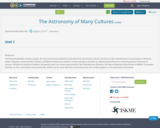
This downloadeable resource guide, for instructors and students in introductory astronomy courses, focuses on the contributions to astronomy of African, Asian, Hispanic, South Pacific, Islamic, and Native American cultures. It also contains a section on reports and articles for achieving greater diversity in science. Written by Andrew Fraknoi, the guide is part of a series sponsored by the Heliophysics Forum of the Space Missions Directorate at NASA. It includes written, on-line, and audio-visual materials, which can be used directly in the classroom, for student papers, or for personal enrichment.

This course provides a graduate-level introduction to stellar astrophysics. It covers a variety of topics, ranging from stellar structure and evolution to galactic dynamics and dark matter.

This is the second course in a two-semester sequence on astrophysics. Topics include galactic dynamics, groups and clusters on galaxies, phenomenological cosmology, Newtonian cosmology, Roberston-Walker models, and galaxy formation.
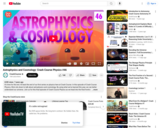
It's time for the end. At least the end of our first series on physics here at Crash Course. In this episode of Crash Course Physics, Shini sits down to talk about astrophysics and cosmology. By using what we've learned this year, we can better understand our universe. Join us for this final episode of Crash Course Physics as we head into the final frontier.